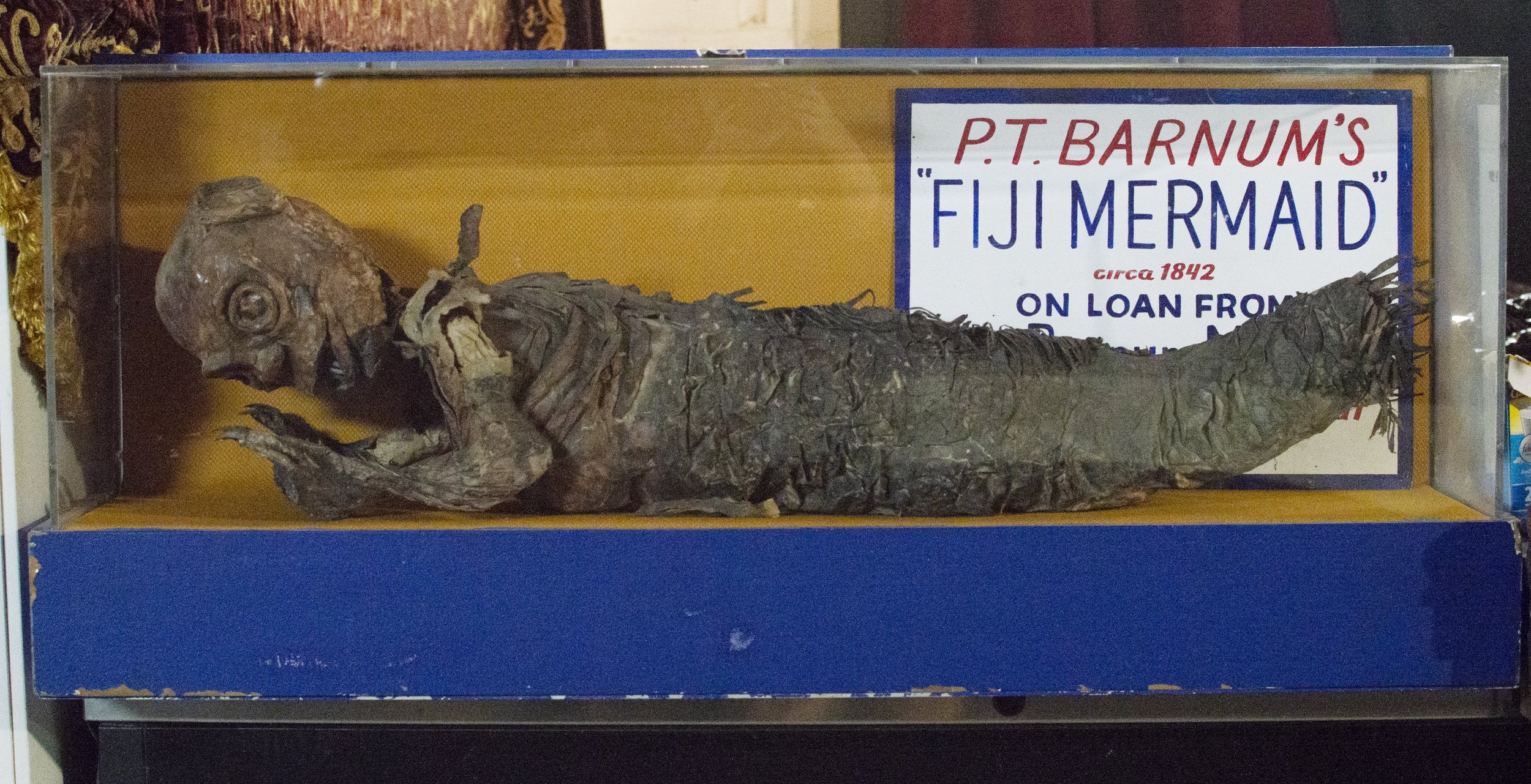Attraction | 2008
Feejee Mermaid
The tale of how the half-human, half-fish creature went from Japanese folklore to Western phenomenon and ended up in the collections of esteemed institutions.
Mermaids are common in folklore of many cultures. Mesopotamian mythology has Oannes, a man with a fish overlay; Greek mythology has Triton, a merman, and Nereids, sea nymphs; the Irish have tales of merrows, mermaids and mermen; Scotland has easg, half-woman, half-salmon; the Irish and Scottish have selkies, half-human half-seal. None come close to capturing the appearance of a feejee mermaid, except that of the Japanese legend of ningyo,“human fish”.
Ningyo is a genderless, human-like, monkey, fish hybrid. One of the earliest records of this human-fish hybrid creature is in the Nihon Shoki, one of the oldest books in Japanese history. The book was compiled in 720 AD and contains Japan’s early mythology. The earliest record of the word “ningyo” is from 937 AD, in Japan’s oldest Japanese-Chinese dictionary. Later books of tales and historical records describe fishermen catching fish with human heads, the face of monkeys, and the bodies and teeth of fish. Some stories say they tasted delicious and owning one offered protection from illness, others said they were bad omens and when they washed ashore disaster should be expected.
The legend most closely associated with ningyo is that of Yao Bikuni, the “Eight-hundred Year Nun”. There is some form of the legend throughout all of Japan with variations in the details of who the woman once was and what life she ended up living. The most common version is that a man comes into possession of a ningyo under the pretense that it is a fish. Knowing that it is a ningyo, he doesn’t eat it, but his daughter somehow accidentally eats the fish, not knowing what it was. She gets cursed with eternal youth and life, watching her father and husbands age and die while she stays young. She becomes a nun and continues to live a lonely life for 800 years.
Potentially the oldest feejee mermaid is on display in the Tenshou-Kyousha shrine in Fujinomiya, Japan. The mermaid could be close to 1,400 years old. The legend goes that the mermaid appeared before Prince Shōtoku in Lake Biwa. As the ningyo was dying, it told the prince how he was originally a fisherman. He trespassed into protected waters to fish and, as a result, was punished by being turned into a ningyo. He felt remorse for his actions and wanted the prince to pardon him and to display his body in a temple as an example of the importance of life and as a cautionary tale.
Undersea creature (ningyo or mermaid), created by Kawahara Keigaca. Japan, 1828. From the collection of the Freer Gallery of Art
During the Edo period in Japan, between the early 1600s and late 1800s, misemono, the Japanese equivalent of a sideshow or carnival, was a popular form of entertainment. Many misemonos included animal hoax attractions. There, Jan Cock Blomhoff, head of the Dutch trading colony Dejima, purchased a feejee mermaid. That feejee mermaid is at the National Museum of Ethnology in Leiden. When Japanese sailors realized that they could sell these hoax mermaids to foreigners, they saw an opportunity to profit.
Feejee mermaids gained popularity in America when P.T. Barnum put one on display at his American Museum, in New York, in 1842. It is thought that the mermaid he displayed was originally created by a Japanese fisherman, who sold it to a sailor, who sold it to an American captain, Samuel Barrett Edes. It cost Edes $6,000, equivalent to over $100,000 today. Edes didn’t have all the money in-hand, so he “borrowed” some from his ship’s expense account, hoping to replace the money after he exhibited the mermaid. Eventually, in 1822, the company he worked for found out about the missing money and legal action was taken. The money was repaid over time, and Edes got to keep the mermaid. He displayed the mermaid in London at the Turf Coffee House. Allegedly, hundreds of guests came to view the mermaid a day. While in London, William Clift of the Royal College of Surgeons examined the mermaid and declared it a fake. By 1823, the mermaid was done in London. The public knew it was a fake.
The Mermaid, Now exhibiting at the Turf coffee-house, 39 St. James's Street. Print by Isaac Robert Cruikshank, October 1822 © The Trustees of the British Museum
When Edes died he willed the mermaid to his son, who did not want it. So his son sold it to the Boston Museum in 1942. Moses Kimball at the Boston Museum showed it to Barnum. Barnum was interested in displaying it, but before he did, he showed it to a naturalist. The naturalist said it had to be a fake because mermaids don’t exist.
The New York herald; July 17, 1842
Barnum never had any issues with showcasing fictitious items, but to add a layer of “authenticity”, he fabricated a backstory. He had letters sent to New York newspapers from across the country claiming to have met a Dr. Griffin and knew of a mermaid in his possession. The press even got to glimpse Dr. Griffin going into a hotel, where he showed the mermaid to the press. Dr. Griffin allegedly worked at the British Lyceum of Natural History and found this mermaid in South America. Dr. Griffin and the British Lyceum of Natural History never existed. Dr. Griffin was Barnum’s lawyer, Levi Lyman, who had allegedly worked with Barnum on the Joice Heth hoax a few years earlier. They even manufactured a public disagreement between Dr. Griffin and Barnum by Dr. Griffin refusing to display the mermaid. This riled up the public, and Dr. Griffin finally agreed to have Barnum display the mermaid.
Eastern Times, Bath, Maine; October 10, 1850
Barnum advertised the feejee mermaid with an image depicting mermaids the way most people imagine them. With long flowing hair, seductive, and not the least bit nightmare inducing. Little did the public know, they were going to witness a half mammal, half aquatic monster covered in a weird mix of hair and scales, that sits frozen with a face that looks like it’s crying out in agony. Like many of Barnum’s oddities, the mermaid became a huge attraction.
Coney Island USA's "Fiji Mermaid"
Barnum’s original feejee mermaid is said to have been destroyed in the fire that destroyed his museum in 1865, although many institutions claim to have his mermaid.
The Birmingham age-herald, Birmingham, Alabama; July 12, 1914, Editorial Section
Europe was more skeptical of animal hoaxes than the United States appeared to be. There were a few examples in the 1700s of scientists thinking they discovered a new animal species, only to find out they were duped. This awareness of animal hoaxes led to interesting encounters with real animals, like the platypus. In 1799, the pelt and bill of a platypus was sent from Australia to Zoologist George Shaw in England. Shaw thought it was a hoax, and someone sent him the remains made from an otter or beaver pelt and a duck bill. He inspected the remains, convinced the parts were sewn together. For years, scientists felt the platypus was as real as mermaids.
Feejee mermaids became an “exotic” import item, especially after Japan opened up trade to the rest of the world in 1853. As a result of their popularity and an awareness of how they are constructed, feejee mermaids no longer had to be imported from Japan. People began manufacturing them in the United States.
The daily dispatch. Richmond, Virginia; April 03, 1874
The Kinsley graphic, Kinsley, Kinsley; August 25, 1899
Feejee mermaids would become cheaper to purchase, flooding the market. Soon, they could be seen across the United States.
The Minneapolis journal, Minneapolis, Minnesota; August 08, 1903; Page 19
Due to the large numbers of feejee mermaids that were created, many Western institutions currently have them in their collections, including the British Museum, Mead Art Museum at Amherst College, Hood Museum of Art at Dartmouth College, Peabody Museum of Archeology and Ethnology at Harvard University.
Feejee mermaids saw a resurgence in the late 1930s with Robert Ripley displaying them in his Odditoriums. By this point, the American public knew feejee mermaids were a hoax, and Ripley advertised it as Barnum’s hoax. Feejee mermaids are still displayed at almost all of Ripley’s Odditoriums today.
Robert Ripley at the 1939 New York City odditorium. Photograph from Ripley Entertainment Inc
"Second Texas Take-Out: A skeleton of a mermaid on exhibition in Port Isabel by Coleman who has been making a living for 8 years by charging five cents a look".Texas, 1939. Photography by Carl Mydans
Many of these feejee mermaids are made from parts of fish and paper mache. Few actually appear to contain monkey parts. Over the last decade, museums have been taking a deeper look into their mermaids.The Horniman Museum and Gardens in London thoroughly examined the feejee mermaid they acquired in 1982 using x-rays and CT scans. It is made up of the tail of a carp, and the teeth of a wrasse fish. The head was paper mache and the body was stuffed with fabric. Similarly, The Buxton Museum and Art Gallery’s looked into the components of their Buxton Mermaid. It has human hair, a fishtale, and the chest is made from wood and wire.
Weekly World News; June 17, 2003
Feejee mermaids continue to attract the minds of pop culture, including in the sideshow heavy, 1995 X-Files episode, “Humbug”, Rob Zombie’s 2003 film “House of 1000 Corpses”, and of course, on the cover of Weekly World News. In 2020, the Buxton Mermaid went on exhibit in London’s Natural History Museum for the Harry Potter-inspired “Fantastic Beasts™: The Wonder of Nature” exhibit. They can be bought by anyone with an internet connection on sites like eBay and Etsy.
Written by Eliza Rinn








